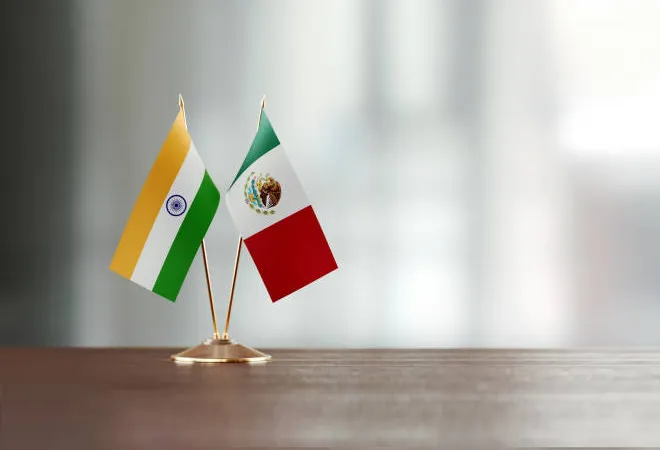
India and Mexico may not be the most obvious partners that come to mind when one reflects upon the strongest bilateral relationships that India has built over the past decades. However, that may be up for a change. In recent years, amidst an increasing frequency of high-level visits between India and Mexico, it has become clear that the two countries are trying to work closely together on various issues. In this regard, the
visit of the Foreign Minister of Mexico, Mr Marcelo Ebrard Casaubón from 30 March to 1 April this year has stood out. His visit to India was part of his 10-day-long tour of the Middle East and India. The Mexican Foreign Minister’s visit to India is being seen as complementing the visit to Mexico in September 2021 by Indian External Affairs Minister Dr S Jaishankar coinciding with the 200
th anniversary of Mexican independence.
The economic relationship between India and Mexico is an expanding spectrum. India and Mexico recently crossed the US $10 billion mark in bilateral trade despite the economic slowdowns caused due to the spread of COVID-19. Furthermore, India is the ninth largest trade partner of Mexico with both countries seeking to move up the ladder. For the past few years, the trade between India and Mexico has been consistently rising, except for a blip in 2020 due to COVID-19 induced disruptions—as shown in the graph below.
 Source:https://tradingeconomics.com/india/exports/mexico
Source:https://tradingeconomics.com/india/exports/mexico
One of the ways to sustain this new-found momentum in bilateral ties will be to explore avenues for further collaboration—an overarching aim of the Foreign Minister’s recent visit. Specifically, cooperation in sectors such has pharma, healthcare, and space stood out during the visit. More importantly, as considerably large and rapidly growing economies of the world, India and Mexico may have found enough opportunities during the three-day visit to exchange views on important issues, and perhaps align views on some including the crisis that besets the current multipolar world order such as increasing polarisation in the global order and their United Nations role. The responses to the ongoing Ukraine crisis from India and Mexico have been somewhat different, yet accommodating. Although India abstained from an important UN resolution that Mexico sponsored together with France, both countries believe that cornering Russia over Ukraine may not be the best solution to the ongoing Ukrainian crisis. In what is a unique opportunity, both India and Mexico will also look to work closely at the G20 in Indonesia in November this year to craft a strategy toward stabilising the global order.
India and Mexico have repeatedly stated their firm belief in a multi-polar world which they are willing to work towards, albeit using
different techniques. As such, the recent visit by Casaubón was a step towards greater cooperation within an emerging multi-polar world that is becoming a reality. India and Mexico joined the United Nations Security Council as non-permanent members for two years in January 2021 and have agreed to work on many issues that plague countries of the Global South. As the two countries seek to further bolster their “
strategic partnership”, it is natural that India and Mexico would begin to examine sectors that provide avenues for greater collaboration.
India and Mexico joined the United Nations Security Council as non-permanent members for two years in January 2021 and have agreed to work on many issues that plague countries of the Global South.
Cooperation in the space sector has emerged as an important area of focus between the two countries, as was evident during this visit. The infinite mysteries and potential of space have fascinated both India and Mexico for a long time and since 2014, India and Mexico have attempted to collaborate in the sector of space exploration. In 2014, ISRO and the Mexican Space Agency signed a pact on ‘
Space Cooperation for Peaceful Purposes’. In 2019, three officials of the Mexican Space Agency also participated in the training on forest fire regulation through Remote Sensing. That curiosity to further joint space exploration has continued and even during this visit, the Mexican Foreign Minister
met with the Chief of the Indian Space Research Organisation (ISRO), Dr S Somanath.
While space exploration and technology became a sector that garnered much interest from both the countries, a larger and more comprehensive discussion also took place which only befits the needs of global politics of the hour. In the same week, as the Casaubon visited, India was also
hosting the foreign ministers from Russia and the UK, and a surprise visit from their Chinese counterpart as well as dignitaries from the US. While this sudden collective of foreign ministers in India may have been emblematic of India’s relations with great powers in a swiftly changing world, Mexico’s representation proved the commensurate importance India attaches to its ties with middle powers and above all, in robust South-South cooperation.
It is also pertinent to mention that while the relationship between India and nations of Latin America is not the most widely mentioned, India has been actively working towards expanding and consolidating its presence in the Latin American region. Mexico and India have shared a ‘privileged partnership’ since the year 2007, and later in the year 2016, when Prime Minister Modi visited New Mexico and met with the former Mexican President Peña Nieto, the two nations decided to elevate it to this status to a ‘
strategic partnership’. It was also in 2016, that Mexico announced that they wanted India and Mexico to be a part of a long-term alliance and move beyond a buyer-seller relationship.
The two nations established diplomatic relations back in the year 1950, much before India could establish diplomatic relations with most nations in the world.
The potential for energy cooperation, space exploration, IT, pharmaceutical, aerospace technologies, agriculture, renewable energy, as well as joint research on climate change and natural disasters that were mentioned during that visit in 2016 have all found steady growth in the flourishing relationship between the two countries.
Such growth is only befitting to the history between India and Mexico. It should be noted that Mexico was the first country in the Latin American region to recognise India post-independence. The two nations established diplomatic relations back in the year 1950, much before India could establish diplomatic relations with most nations in the world. Such an enthusiastic response to the Indian independence was soon followed by a continued exchange of high-level visits, despite the obvious geographical distance between the two nations. This included a visit to Mexico by India’s first Prime Minister Pt. Jawaharlal Nehru in the year 1961, which was complemented by the President Adolfo Lopes Mateos’ visit to India the following year, in 1962.
The initial momentum imparted to the bilateral ties between the two countries did not find the same enthusiasm and a relatively dormant state followed. However, in recent years, particularly in 2007, this slumber was broken when President Felipe Calderon decided to visit India. It was during this visit, that India and Mexico augmented their bilateral relations and elevated it to the status of a ‘
privileged partnership’. Since the elevation of the status of Indo-Mexican relationship, the two countries have worked closely towards forging wider connections. Much in keeping with this objective, Pratibha Devi Singh Patil, the former Indian President visited Mexico in 2008.
India and Mexico, separated by long distance, face the tyranny of geography to their disadvantage. However, notwithstanding this distance, India and Mexico share commonalities in the global space including in the Indo-Pacific region. Their
growing commonalities in global forums including in the UN, G-77, G-15, and G20 have brought to the fore new opportunities for cooperation on bilateral and multilateral issues.
As the two countries have begun to overcome their traditional hurdle of their lack of geographical proximity, and begin to stabilise their positions in a rapidly changing world—sustained growth in their bilateral relationship may be in order.
The views expressed above belong to the author(s). ORF research and analyses now available on Telegram! Click here to access our curated content — blogs, longforms and interviews.



 India and Mexico may not be the most obvious partners that come to mind when one reflects upon the strongest bilateral relationships that India has built over the past decades. However, that may be up for a change. In recent years, amidst an increasing frequency of high-level visits between India and Mexico, it has become clear that the two countries are trying to work closely together on various issues. In this regard, the
India and Mexico may not be the most obvious partners that come to mind when one reflects upon the strongest bilateral relationships that India has built over the past decades. However, that may be up for a change. In recent years, amidst an increasing frequency of high-level visits between India and Mexico, it has become clear that the two countries are trying to work closely together on various issues. In this regard, the 
 PREV
PREV



